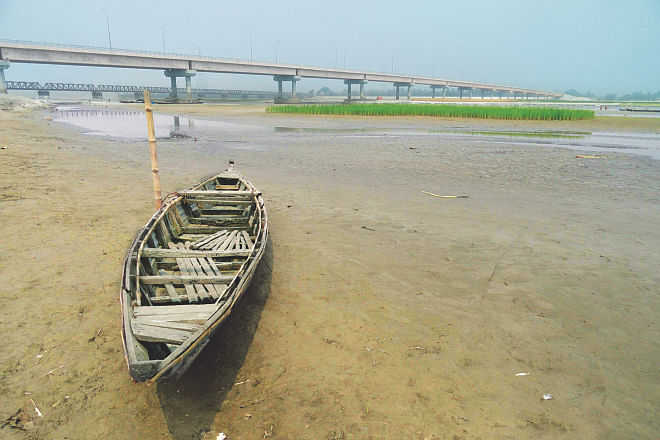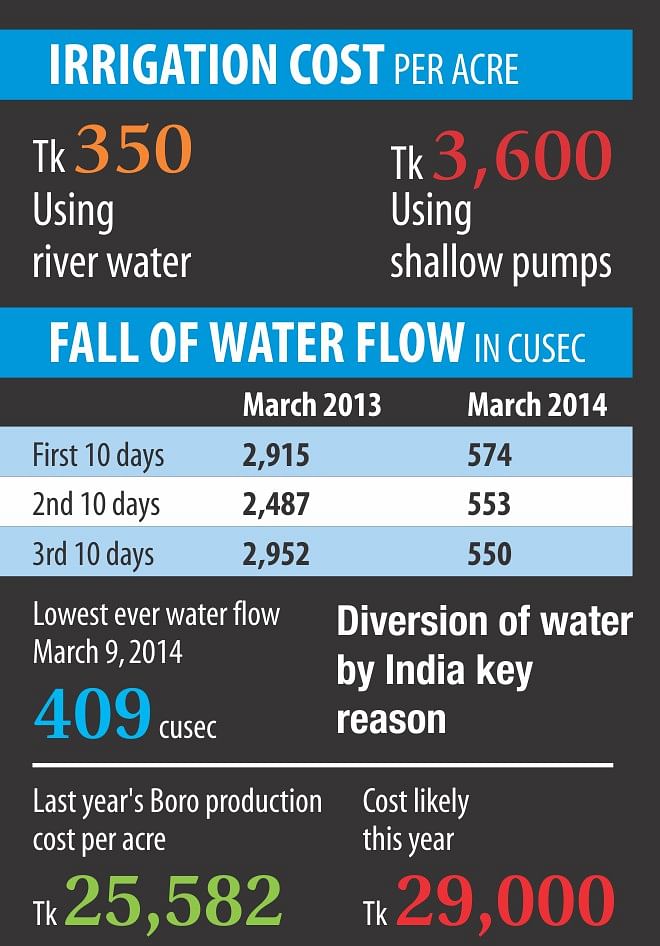Teesta woes for farmers
Teesta woes for farmers
Amid sharp decline in water level, farmers forced to go for costly irrigation

Boro farmers in four northern districts are counting the cost of India's massive withdrawal of Teesta water.
There is no water in the irrigation canals in the region at the peak of the Boro season, as the Indian authorities have blocked the water flow at Gajaldoba barrage in West Bengal.
In a predicament, farmers have turned to commercial shallow pump operators to irrigate their croplands, but at a high price -- it is costing them around Tk 3,300 extra per acre.
The operators charge at least Tk 3,600 per acre. It would cost the farmers just Tk 350 if Teesta water was available.
Bangladesh is getting only 10 percent of the water it needs for irrigation under the Teesta barrage irrigation scheme. The water flow stood at over 1,500 cusecs (cubic feet per second) in January, which dropped to 409 cusecs on March 9. The maximum water flow has been recorded at 650 cusecs since.
This is a sharp fall in the water flow, which hovered around 3,000 cusecs last year.
The dried-out Teesta is badly affecting the lives of around 9 million people in 5,427 villages under 35 upazilas of five northern districts -- Gaibandha, Kurigram, Lalmonirhat, Nilphamari and Rangpur.
“If we don't buy irrigation water from the commercial shallow pump operators, all our crops will die,” said Majibor Rahman, a farmer of Chapanirhat in Dimla of Nilphamari.
The extra cost of irrigation will push up the production cost, and farmers are worried that they will not be able to make any profit.

Last year, production cost of Boro was Tk 25,500, excluding irrigation cost, per acre. The high irrigation cost this year makes the crop's production "very challenging," said experts at Bangladesh Rice Research Institute (BRRI).
“The land rent is not included in this cost. If farmers rent land from other people, the cost will increase further and they will not be able to make any profit," said Abdus Salam, senior scientific officer at BRRI.
Like Majibor Rahman, tens of thousands of farmers who are cultivating on around 14 percent of the country's cropland in the northern region, are in a dire situation, as they depend on Teesta water.
The Teesta barrage irrigation scheme covers 60,500 hectares (151,250 acres) of cropland in four northern districts -- Kurigram, Lalmonirhat, Nilphamari and Rangpur. It requires about 4,500 cusecs of water in the Teesta to irrigate the land.
“Today, we got only 650 cusecs, which was between 1,500 and 2,000 in January [this year]. It was around 3,500 cusecs during this time last year,” Mir Sazzad Hossain, member of Joint Rivers Commission (JRC), Bangladesh, told The Daily Star on Saturday.
On an average, Bangladesh got 4,670 cusecs of water in February from 1967 to 1997, says water board records. Before India started to intervene in the 1980s, the flow was around 10,000 cusecs in lean period.
Bangladesh raised the issue at a JRC meeting with India last month and wrote two letters to the Indian authorities since February. The foreign ministry sent a separate note to the Indian government, requesting it to resolve the issue. But the issue is yet to be addressed, said Sazzad.
“There might be some progress after the elections in India, but it will be too late as farmers are already facing problems," he added.
But even after the election, the Indian government will have its internal issues to be resolved. Mamata Banerjee, the West Bengal chief minister, at an election campaign on Saturday urged voters to teach the centre a lesson through ballots, as the centre wanted to "deprive India's North Bengal people of drinking water by giving away water to Bangladesh.
It is because of Mamata's last-minute opposition that the Indian government could not sign the Teesta water sharing deal with Bangladesh in 2011 during Indian Prime Minister Manmohan Singh's Dhaka visit.
And while India is diverting the water of the trans-boundary river to meet its own demand, farmers in Rangpur have turned to buying shallow pumps. But they cannot get adequate water even with these pumps, as the ground water level has been steadily falling.
Firoze Ahmed, Rangpur division director of the Department of Agriculture Extension, said around 80 percent areas of the northern districts are being irrigated with the shallow pumps.
Shallow pumps can usually lift water from 26 feet deep. But the water level has dipped to 36 to 40 feet in most areas.
“So the farmers have to first dig around 10 feet before they start lifting water with shallow pumps,” said Firoze.
But it is not only about farmers. People of other communities like fishermen and boatmen are also dependent on the Teesta, and they are all suffering as they have lost their livelihoods, said Faridul Islam, convener of Bangladesh Teesta Bachao Andolon.
“Even a hen can now walk across the Teesta, as the river is completely dried up," he added.
A fishermen from Nohali under the Gangachara upazila said they had no income as they could not catch a single fish in the last two months.
The Teesta, the fourth largest trans-boundary river of Bangladesh, merges with the Brahmaputra at Teestamukh Ghat in Rangpur, after travelling about 414 km through India and Bangladesh.